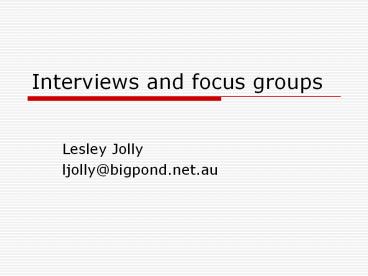Interviews and focus groups - PowerPoint PPT Presentation
Title:
Interviews and focus groups
Description:
Interviews and focus groups Lesley Jolly ljolly_at_bigpond.net.au Semistructured interviews attempts to understand the world from the subjects' point of view, to ... – PowerPoint PPT presentation
Number of Views:69
Avg rating:3.0/5.0
Title: Interviews and focus groups
1
Interviews and focus groups
- Lesley Jolly
- ljolly_at_bigpond.net.au
2
Semistructured interviews
- attempts to understand the world from the
subjects' point of view, to unfold the meaning of
peoples' experiences, to uncover their lived
world prior to scientific explanations." (Kvale,
1996). - NOT for finding out about population parameters
3
When to use interviews
- to generate ideas
- to develop a greater understanding of an issue or
topic - to refine a research question
- to evaluate the impact of a particular program,
policy or issue - to gain key stakeholder support
4
Circumstances calling for interviews
- High status people are involved as respondents
- People with extensive knowledge or expertise are
involved - The population to be interviewed is small and
homogeneous - You need in-depth information
- The topic is sensitive, or the operating
environment is sensitive and discretion is
important
5
How to use interviews
- Mix with other methods
- Eg early in research to design surveys or late in
research to explore issues raised by surveys - Use interview guide
- List of topic areas to be covered
- Ask good questions
- Concrete, concise, probing
6
How to probe
- Getting more information without injecting
yourself too much - Silent probe wait for answer/expansion
- Echo probe repeat whats said and ask for more
- Back channel uh-huh
- Tell-me-more why do you feel that?
- Long question you elaborate
- Phased assertion reveal what you know
7
Focus groups
- Not just a group interview members chosen as
representative of sub-group in factorial design - Should be done in series balanced with other data
gathering techniques - Members should be homogenous on independent
variables and not know each other. - See The Focus Group Kit by D. Morgan et al
8
Analysing data
- Coding (Berkowitz, 1997)
- What patterns and common themes emerge?
- Are there any deviations from these patterns? If
so, how can these be explained? - What interesting stories emerge from the
responses? - Do any of these patterns suggest that additional
data may be needed? - Do the patterns that emerge corroborate the
findings of any corresponding qualitative
analyses that have been conducted? - If not, what might explain these discrepancies?
9
Some references
- Kvale, S. (1996). Inter Views An Introduction to
Qualitative Research Interviewing. Thousand
Oaks, CA Sage. - Rubin, H.J. Rubin, I.S. (2004). Qualitative
Interviewing The Art of Hearing Data (2nd ed.).
Thousand Oaks, CA Sage. - Denzin, N.K., Y. S. Lincoln (ed). 1998. The
Landscape of Qualitative Research. Thousand Oaks,
CA Sage. - Minichello, V., R. Aroni, E. Timewell and L.
Alexander. 1995. Indepth Interviewing
Principles, Techniques, Analysis. Melbourne
Longman.































